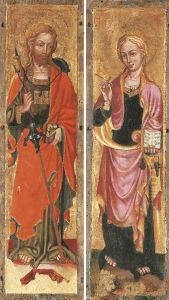The Zavattari Family Paintings
The Zavattari family, active during the 14th and 15th centuries in Lombardy, Italy, was a dynasty of painters whose members are best known for their work in the Lombard Gothic style. Unfortunately, specific birth and death dates for individual members of the family are not well-documented, as was often the case with artists of the period. The family's work is primarily associated with the International Gothic style, which combined Gothic forms with courtly elegance and an emphasis on decorative detail.
The most notable project attributed to the Zavattari family is the series of frescoes in the Chapel of Theodelinda in the Duomo of Monza. These frescoes, completed around the mid-15th century, depict scenes from the life of Queen Theodelinda, a Bavarian princess who became a queen of the Lombards. The frescoes are celebrated for their rich narrative detail and vibrant use of color, characteristics which are hallmarks of the International Gothic style. Due to the collaborative nature of their work, it can be difficult to distinguish individual contributions within the family. The Zavattari studio included multiple generations, with the most prominent figures believed to be Cristoforo and Franceschino Zavattari.
Art historians often face challenges in attributing specific works to the Zavattari family due to scant documentation. However, their influence is recognized in various ecclesiastical commissions throughout Lombardy, where they decorated churches and cathedrals with frescoes and altarpieces, contributing to the rich artistic landscape of the region during the late Middle Ages. The legacy of the Zavattari family is encapsulated in their surviving works, which continue to be studied for their representation of the cultural and artistic transitions between the Gothic and Renaissance periods.
